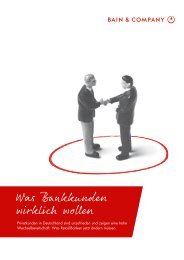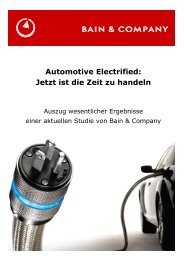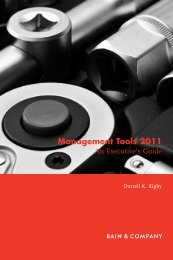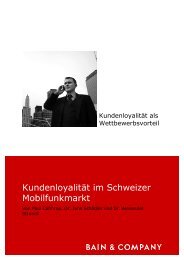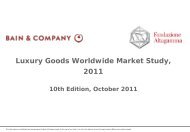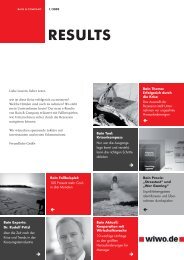Service now! Time to wake up the sleeping giant - Bain & Company
Service now! Time to wake up the sleeping giant - Bain & Company
Service now! Time to wake up the sleeping giant - Bain & Company
Create successful ePaper yourself
Turn your PDF publications into a flip-book with our unique Google optimized e-Paper software.
3. Strategy development: Where <strong>to</strong> play<br />
Developing a service strategy starts with a clear understanding<br />
of <strong>the</strong> current state of <strong>the</strong> manufacturer’s<br />
service business and <strong>the</strong>n making choices about its<br />
future and its impact on <strong>the</strong> rest of <strong>the</strong> company. Leaders<br />
begin by gaining a clear picture of <strong>the</strong> existing<br />
installed base and competitive situation and <strong>the</strong>n<br />
clarifying <strong>the</strong> full-service potential. The ambitions<br />
for new services should reflect future cus<strong>to</strong>mer development,<br />
define clear cus<strong>to</strong>mer value and allow<br />
for regional differences. Manufacturers can expand<br />
<strong>the</strong>ir service ranges along three vec<strong>to</strong>rs: products<br />
that can be serviced, cus<strong>to</strong>mers who are in easy reach<br />
and existing capabilities that can be tapped.<br />
The most important source for OEM service contracts<br />
is <strong>the</strong>ir own equipment already installed with<br />
cus<strong>to</strong>mers. However, <strong>Bain</strong> experience has shown<br />
that few industrial goods manufacturers k<strong>now</strong> <strong>the</strong><br />
location and characteristics of every piece of <strong>the</strong>ir<br />
equipment. In fact, most companies only k<strong>now</strong><br />
where about half of <strong>the</strong>ir equipment is. A deep understanding<br />
of <strong>the</strong> installed base is fundamental for<br />
<strong>the</strong> development of a winning operational plan. An<br />
OEM must k<strong>now</strong> <strong>the</strong> full potential and how it breaks<br />
down by equipment type, cus<strong>to</strong>mer segment, geography<br />
and competitive situation.<br />
Create an installed base inven<strong>to</strong>ry<br />
The first step in expanding product-related services<br />
is <strong>to</strong> develop a complete picture of <strong>the</strong> equipment<br />
<strong>to</strong> be serviced. Identifying <strong>the</strong> relevant equipment<br />
types, numbers and technologies in use at cus<strong>to</strong>mer<br />
sites is a time-consuming task, but <strong>the</strong> effort pays<br />
off. In <strong>Bain</strong>’s experience, increasing identification of<br />
installed equipment <strong>to</strong> 80% <strong>to</strong> 90% can help double<br />
service possibilities.<br />
<strong>Service</strong> <strong>now</strong>! <strong>Time</strong> <strong>to</strong> <strong>wake</strong> <strong>up</strong> <strong>the</strong> <strong>sleeping</strong> <strong>giant</strong><br />
What service champions do<br />
• Identify service share distribution with international<br />
cus<strong>to</strong>mers, country by country, and align service market<br />
share with new product shares<br />
• Offer a free diagnosis <strong>to</strong> “lost” cus<strong>to</strong>mers <strong>to</strong> re-engage<br />
<strong>the</strong> relationship<br />
• Develop complete ready-<strong>to</strong>-replace modules or kits<br />
for competi<strong>to</strong>r equipment, and address cus<strong>to</strong>mers with<br />
a mixed installed base of competing equipment<br />
Spotlight: assessing and exploiting installed base service potential<br />
Assess service potential per unit<br />
The second step is <strong>to</strong> compute <strong>the</strong> potential service<br />
revenues that can be made from <strong>the</strong> identified installed<br />
base. A full-potential assessment multiplies<br />
<strong>the</strong> installed base with <strong>the</strong> maximum number of<br />
services possible for each equipment type and compares<br />
this with <strong>the</strong> <strong>to</strong>tal of actual service market<br />
sizes in each region. Analyses of cus<strong>to</strong>mer buying<br />
behavior, regional differences, offerings of existing<br />
service providers and regional differences in prices<br />
and cus<strong>to</strong>mer <strong>up</strong>take give a picture of how much additional<br />
service business <strong>the</strong> OEM can gain. Usually<br />
such an assessment will uncover significant service<br />
growth potential.<br />
Initiate service improvements<br />
Once companies have assessed <strong>the</strong> potential, <strong>the</strong>y<br />
can set <strong>to</strong> work selling service by finding regional<br />
gaps, increasing <strong>the</strong> coverage of <strong>the</strong> field workforce,<br />
acquiring service companies, identifying industry<br />
segments with low service penetration rates, raising<br />
salesforce effectiveness, and offering pricing incentives<br />
and maintenance contracts. Current cus<strong>to</strong>mers<br />
are good prospects for <strong>up</strong>grades and replacement<br />
offers. OEMs can bundle service contracts with new<br />
equipment sales or at o<strong>the</strong>r key moments, including<br />
installation, <strong>the</strong> end or extension of a warranty or<br />
after repairs.<br />
11






